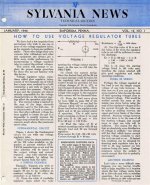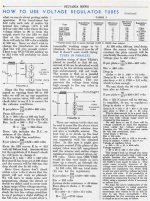Hi jarthel,
Yes, Pete Millet has a treasure trove of great information and scanned texts. The site is right here. Thank you for reminding me.
CarlyBoy, I warn you, you'll spend hours here!
-Chris
Yes, Pete Millet has a treasure trove of great information and scanned texts. The site is right here. Thank you for reminding me.
CarlyBoy, I warn you, you'll spend hours here!
-Chris
Is it possible that since most tube amps are made with high impeadence unregulated supplies, that if you do regulate it, that there will be no audible difference between SS or Tube regulators? I mean after all the tube is now seeing, from a tube perspective, a perfect power supply. BTW, there is more sand in any tubes vacuume envelope than sand in any transistor!
TUBESMAN said:Is it possible that since most tube amps are made with high impeadence unregulated supplies, that if you do regulate it, that there will be no audible difference between SS or Tube regulators? I mean after all the tube is now seeing, from a tube perspective, a perfect power supply. BTW, there is more sand in any tubes vacuume envelope than sand in any transistor!
I think it has been discussed that this thread is not about tube vs SS regulation
There hasn't been a standard line type SS HV power supply that has survived the onslaught of my lab with the pass transistor surviving. A Tube series regulated unit is simpler and pretty bomb proof against output shorts. The regulation and spec of the SS may be fantastic but in the real world of tubes we don't need such precision.
richj
richj
Put simply, voltage regulation is achieved by reducing the supply voltage to maintain a constant ouput voltage, under varying supply and load conditions. This requires the regulator's input voltage to be higher than its output voltage at all times, by a minimum amount that depends on on the regulating device's characteristics and the current demanded.
I think that a disadvantage of series tube regulation (as opposed to using an SS device) is that a higher supply voltage is required for a given output voltage; however, I don't know the magnitude. Can somebody say what the typical minimum plate-cathode voltage would be for a regulator triode (e.g. 6AS7) for different currents, say, 50mA, 100mA and 150mA?
BTW, I couldn't find any info on regulators at Pete Millet's site. Where exactly is it?
I think that a disadvantage of series tube regulation (as opposed to using an SS device) is that a higher supply voltage is required for a given output voltage; however, I don't know the magnitude. Can somebody say what the typical minimum plate-cathode voltage would be for a regulator triode (e.g. 6AS7) for different currents, say, 50mA, 100mA and 150mA?
BTW, I couldn't find any info on regulators at Pete Millet's site. Where exactly is it?
TUBESMAN said:Is it possible that since most tube amps are made with high impeadence unregulated supplies, that if you do regulate it, that there will be no audible difference between SS or Tube regulators? I mean after all the tube is now seeing, from a tube perspective, a perfect power supply. BTW, there is more sand in any tubes vacuume envelope than sand in any transistor!
I agree with you, but it is for the different topic:
http://www.diyaudio.com/forums/showthread.php?s=&threadid=88823
ray_moth said:
BTW, I couldn't find any info on regulators at Pete Millet's site. Where exactly is it?
I think I mentioned P millett's site because I know he has a copy of the RDH manual somewhere and chapter 33 talks about tube regulation.
CarlyBoy said:Hey Folks,
I'd like to learn more about series voltage regulation with tubes. Anyone aware of a site that has a good explanation of the development of such circuits? Two good ones I'm aware of are John Atwoods's at TubeCad and Steve Bench's.
Thanks for any help.
That's not so difficult. When I needed an active regulator for a project, I simply adapted a common SS design to glass. The VT version is a bit tougher to design, but only a little.
[img=http://img209.imageshack.us/img209/9980/screenregpw0.th.gif]
Since the current demand isn't particularly high, I went with a trioded 6AQ5, since I already had these on hand. The main difference is that the cathode will be at a higher positive voltage than the grid, the opposite situation when using sand state. To find out how to bias the 6AQ5, simply draw up a loadline:
[img=http://img209.imageshack.us/img209/6162/6aq5aloadlineel7.th.png]
Again, NBD, since we know the input voltage (365Vdc) and the desired output (270Vdc) which gives the operating Vpk: 95Vdc. Then, just pick off the required current minimum and maximum. That'll tell you what the Vgk range will be, and the voltage output from the error amp.
As for the selection of a suitable error amp, a high gain is a good thing for enhanced accuracy. The 6CB6 works out nicely here. It has a nominal g(m) of 8.0mA/V, and an unusually high Vhk rating: 200Vdc. For a small signal tube, that is well above the more usual rating of 90Vdc or so. It also doesn't have a high Vsgsg either. At 125Vdc, this is below that required by types like the 6AU6 (150Vdc) or 12BY7A (180Vdc). In this application, that is also a benefit in that the screen volatge can be kept below the plate voltage. Then, all you need to do is draw a loadline for the error amp, that comes close to providing the output voltages that the series pass tube needs:
[img=http://img215.imageshack.us/img215/2075/6cb6aloadlinehz2.th.png]
In this case, an Rp= 6K8 looks real good. So that's what I went with for this design. As for the reference voltage, 105Vdc will work since it's less than the required voltage, and the 105V regulator tube is also a miniature type that matches the 6AQ5 and 6CB6. Other than that, a VR75 would do just as well.
As for scaling the feedback voltage divider, all VTs operate differentially since the voltage that counts is Vgk, and not the grid-to-ground voltage. Regardless of where you set the slider, the 6CB6 will always move the regulated output voltage so as to minimize the difference between the grid and the cathode. Figure that there will always be 105Vdc at the 6CB6 grid, and use that to figure out what output voltage at the top of the divider will give that 105Vdc.
As for stabilization and noise reduction, include the 0.1uF Cdom. Here, Mr. Miller is our friend since this extra capacitance will add AC rolloff so as to prevent any oscillations. Also taken from SS practice.
As for effectiveness, this regulator can hold its output voltage to 0.8V over a 40V DC rail variation. It is also dead quiet. With no additional adjustments, the output volatge hasn't moved at all over 10 months. I'm not expecting having to make any adjustments until it's necessary to replace VTs.
Hello ,
it´s only in german language , but with many , many circuits .
Regards , Alexander .
http://www.jogis-roehrenbude.de/Roehren-Geschichtliches/Roehren-Netzteile/Roe-Netzteile.htm
it´s only in german language , but with many , many circuits .
Regards , Alexander .
http://www.jogis-roehrenbude.de/Roehren-Geschichtliches/Roehren-Netzteile/Roe-Netzteile.htm
Well, I know there are great debates over tube vs SS, and series vs shunt, but I recently completed a 12BH7 line stage with series tube regulation, which should look familiar to Frank, and I think it's sonics are significantly surpassing those of both my heavily-modded Foreplay and ASL AQ pre-amps. Noise floor, so far, is excellent. It is also very musical, meaning I tap my toes every time it is playing. If you're inclined to try one, why not? Of course, you might also like your next version, which might very well be a shunt regulated tube PS, or a SS or... whatever. I never understand the desire to berate one design or the other. Eventually, we have to build them all, don't we?http://www.diyaudio.com/forums/attachment.php?s=&postid=165634&stamp=1051169517
cantskienuf said:Eventually, we have to build them all, don't we?[
Why?
Oh sorry, the "Why?" question is for another topic... About sound signatores of power cords...
Well, I hope nobody builds that one, it could destroy the tubes! There is no consideration given to heater-cathode voltage limits.Eventually, we have to build them all, don't we?
You need two separate heater windings, one for the EL86 pass tube (max h-k 200v) and another for the ECC83 cascode (max h-k 100v; strange choice of tube for a cascode!). Each heater supply must be biased at a suitable voltage above ground.
Don''t imagine that ordinary regulators, of either tradition, are a pancea.
Non regulated supplies suffer with a rise in impedance at the VLF end, ie they droop under sustained load. This can have some effect on sonics. We attempt minimise this by over-sizeing.
Regulated supplies do not suffer from this, but can have worse problems: Plot the source Z vs frequency of many regulators and you may be shocked to find that the impedance rises within parts of the audio spectrum.
Producing a regulator that is as flat as a plain 'ol capacitor and good transient response is not trivial.
BTW Welcome back Frank
Non regulated supplies suffer with a rise in impedance at the VLF end, ie they droop under sustained load. This can have some effect on sonics. We attempt minimise this by over-sizeing.
Regulated supplies do not suffer from this, but can have worse problems: Plot the source Z vs frequency of many regulators and you may be shocked to find that the impedance rises within parts of the audio spectrum.
Producing a regulator that is as flat as a plain 'ol capacitor and good transient response is not trivial.
BTW Welcome back Frank
- Status
- This old topic is closed. If you want to reopen this topic, contact a moderator using the "Report Post" button.
- Home
- Amplifiers
- Tubes / Valves
- Tube Voltage Regulator Design

